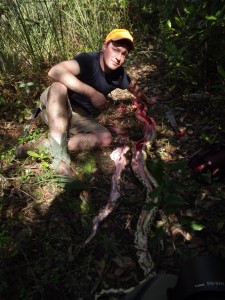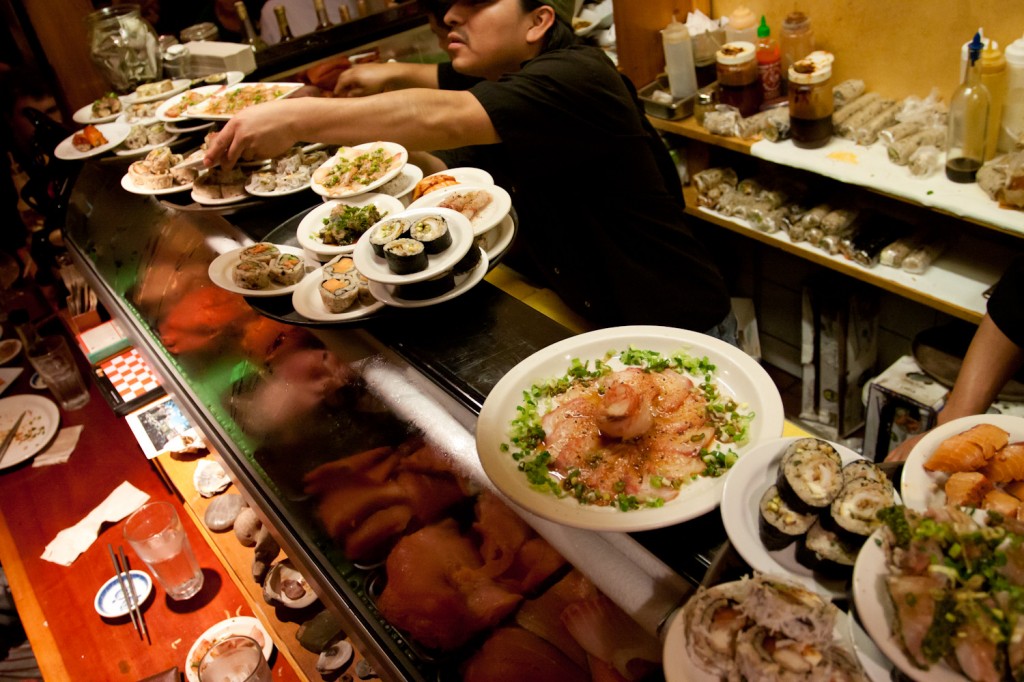
Python may taste like chicken, but offer a snake nugget to your average diner, and watch them go running in the other direction. Likewise, given a choice between carp and salmon, most American eaters would surely choose the salmon, even though carp have almost comparable levels of omega-3’s.
Simply put: We’re used to eating certain animals and not others.
Some adventurous souls, however, are hoping to change our staid diets — and save troubled ecosystems — by introducing diners to a new class of cuisine: invasive species. Last Wednesday, a hunter, a chef, and a biologist gathered at Yale to debate the ecological impacts of consuming invasive species, as well as how effective the practice could be in reducing invasive populations.
According to Jackson Landers, hunter and author of Eating Invaders, invasive species are not only readily accessible to the average consumer, they’re also tasty and sustainable alternatives to commercially caught or farmed species. When harvesting efforts are focused in a contained area, he contended, eating invasive species could be a boon to conserving local ecosystems.
Bun Lai, owner of New Haven’s sustainable sushi staple Miya’s Sushi, is a well-known invasive-eating advocate in these parts. Miya’s model, as anyone who’s eaten there can attest, is trying to shake up what we consider appropriate to eat. “Why can’t we eat away pestilent species that are also nutritious?” Lai asked.
Lai practices what he preaches: to the delight of some patrons and the outrage of others, his sushi menu lacks the usual tuna, salmon and shrimp, on the grounds that they’re considered unsustainable. In their place, Lai offers Asian shore crab (which has infested Connecticut shorelines), lionfish, and invasive seaweeds such as dead man’s fingers (tasty despite the unappetizing name).

Daniel Simberloff, a renowned biologist from the University of Tennessee, injected a note of caution into the proceedings by cautioning that no studies have shown a direct link between consumption of invasive species and any measurable impact on their populations. “This is just an idea,” Simberloff pointed out. “It hasn’t really been shown that it has an impact on the invaders, and it’s probably damaging to suggest to the public and its policymakers that this is really going to solve the problem.” What’s more, creating a market for an invasive species could actually lead to its dispersal beyond the regions where it had originally invaded.
Landers conceded that for most invasive species, eradication is an unattainable goal. Landers had recently returned from the Everglades, home to an estimated 150,000 invasive Burmese pythons. The month-long Python Challenge, a recent competition hosted by the state of Florida to hunt pythons, managed to turn up a grand total of 68 snakes. When you’re dealing with a creature as wily as the python, the issue isn’t eating the invasive species — the problem is capturing them at all.
When Bun Lai does manage to get his hands on an invader, his culinary experimentation is based closely on work with experts. “I’m not going around half drunk sticking weird things in my mouth,” he said with a sly grin. Lai has partnered with biologists at the Connecticut Department of Energy and Environmental Protection and the National Oceanic and Atmospheric Administration to develop a keen knowledge and understanding of our local ecosystem, an understanding that is reflected in his cooking. Wrapped in each sushi roll is the seed of a new conversation about the culture of eating that he plants within the minds of his customers.
And therein lies the big question: Isn’t it time we took a good, hard look at our cultural consumption norms and asked whether we need to change the menu? All three experts agreed that our current track is already devastating the environment, but they also recognized the immense difficulties of dislodging dominant systems.
The panel explored the example of the silver carp, an invasive species now found in estuaries across North America. Campaigns like the Silverfin Craze have attempted to rebrand and market silver carp as an alternative to species like cod, particularly in products like freezer-aisle fish sticks, wherein the species is unspecified. Yet the obstacles are immense: namely, existing processing facilities would have to be updated to handle the bonier carp. Simberloff also noted that silver carp advocates come up against a fierce group of stakeholders when trying to get a foothold in the market. Just as Big Coal has long opposed the development of renewables as an alternative source of energy, he proffered that tuna and cod companies are likely to oppose any new competition as long as they have unrestricted access to their threatened resource.

While the industry may not yet be ready to shift focus, the work of people like Lai and Landers encourages us as consumers to start rethinking what we put in our mouths. Short of eating at Miya’s every night, how does the average person go about incorporating invasive species into her diet? Landers suggested learning how to fish for common carp: “Man, when you get one, those are big fish, that’s a lot of food.” Along the coast, do as Lai does and scavenge for green or Asian shore crabs. In the mood for something leafier? Head inland in the spring to forage for Japanese knotweed.
Finally, for the truly hardcore, there are the birds. “I hunted and ate pigeon in Central Park in New York City,” Landers recalled, a bit grimly. “You can hunt them down on foot and use a rock or something.” For every dogged invasive problem, there is an equally resourceful solution.
Author’s note: Panelists advised checking local PCB levels prior to fishing in freshwater or foraging for plants in the New Haven area. Foragers should also be wary of lead levels in plants growing in areas currently or previously used for industrial purposes.